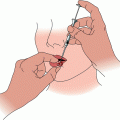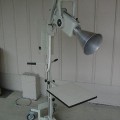Fig. 1
Number of people age 65 and over, by age group, selected years 1900–2006 and projected 2010–2050
In the United States in 2006 there were an estimated 3.5 million new cases of NMSC diagnosed, with the over 65 population responsible for 62 % of these new diagnoses [5]. Rogers et al. [5] using Medicare and U.S. Census Bureau data, in what was perhaps the most complete evaluation to date of the skin cancer epidemic in the United States, noted an increase in the total number of procedures for NMSC from 1,158,298 to 2,048,517 from 1992 to 2006. The authors conclude that the increase was due mainly to an increase in the number of affected individuals (Medicare patients over the age of 65). Comparing this increase over the 1992–2006 time period to the U.S. Census Bureau population projections in Fig. 1, there will be a dramatic surge in the number of new skin cancers within the United States over the next few decades. Due to the aforementioned patient factors, there will be an increasing need for the use of radiation in the treatment of skin cancer, including superficial radiotherapy by dermatologists as well as orthovoltage and electron beam radiotherapy by radiation oncologists, now and in the future. Dermatologists and radiation oncologists are uniquely situated to meet that need and to work with other specialists such as Mohs and reconstructive surgeons.
Reasons that have been cited by dermatologists who do not utilize radiotherapy include safety issues, licensing regulations, maintenance, start-up costs, and a lack of teaching on the practical application and use of superficial radiotherapy. In the next few sections we will explore these areas in greater detail and present possible solutions when needed.
Safety Issues/Radiogenic Carcinomas
Safety issues were once a concern as indiscriminate use resulted in many mishaps early after the discovery of radiation as a potential treatment for various ailments. The government recognizing the need to protect the public and the environment from unrestricted and unlicensed sources of ionizing radiation created the Atomic Energy Act of 1954 and later the Energy Reorganization Act of 1974. Since that time both federal and state regulatory requirements have continued to address safety concerns associated with the use of radiotherapy and adherence to these requirements is necessary for the licensing and safe operation of radiation equipment, thereby minimizing potential hazards associated with the use of radiation. Additionally, modern radiation devices are manufactured with numerous safety mechanisms and systems of redundancy reducing the likelihood of overdosing or radiation accidents. All X-ray machines require annual calibration and certification providing ongoing oversight to minimize the chance of radiation accidents.
In the 1940s and 1950s ionizing radiation was used to treat benign conditions such as tinea capitis and acne. The total dose used for these conditions rarely exceeded 8–9 Gy [6, 7] whereas the dosages used to treat skin cancer are much larger in the order of 35–60 Gy. Today we recognize that radiogenic carcinomas have developed from these smaller nonlethal anti-inflammatory doses of radiation that would be subtherapeutic in the treatment of NMSC. In contrast, the development of secondary tumors using radiation doses required to treat cutaneous carcinoma is rare. In a study by Ehring and Gattwinkel [8] of 2005 patients irradiated for basal cell carcinoma (BCC) only one patient had a second tumor that occurred 40 years after the initial radiotherapy. In contrast the authors report 106 patients who developed radiogenic carcinomas in areas previously treated for benign conditions. Similarly, Bart et al. [9] in a series of 500 patients treated for skin cancer with radiotherapy report only three possible radiogenic carcinomas. The risk of radiation-induced carcinogenesis appears to peak at small doses and declines at doses required to treat skin cancer [10]. It appears that small doses, insufficient to cause cell killing, are able to induce mutagenic alterations leading to skin cancer. Halpern [11] reports that the incidence of radiation therapy-related cancers has been reduced to less than 0.3 % due to refinement of calibration techniques and the availability of more efficacious radiation modalities [12, 13].
Licensing Regulations and Maintenance
Modern radiation equipment is manufactured to comply with federal and state licensing regulations. Facility design requirements are dictated by state health boards and for most states are accessible online. These facility design requirements are intended to protect individuals from unintended radiation exposure and for the safety of the patient being treated. More stringent requirements are necessary for machines operating at higher peak kilovoltages (kVp) usually above 150 kVp. As most radiation equipment used by dermatologists who treat skin cancer operates below 100 kVp the requirements are less stringent. Common requirements include two-way communication between the patient and physician during treatment, direct visualization of the patient during the treatment delivery, and lead shielding of the treatment area. The amount of lead lining required for dermatologists operating at 150 kVp or less is 1/16 of an inch to protect from the direct beam and 1/32 of an inch to protect from scatter, with the requirement that walls be lined up to 7 ft high [14]. Computation of the lead barrier requirements and which walls require shielding is based on occupancy in adjacent rooms, location of the treatment area, and the amount of scatter to adjacent areas. A radiation physicist can determine the amount of scatter and leakage in the treatment area and adjacent rooms to determine which walls, floors, and ceilings require lead lining as well as optimal placement of equipment to minimize radiation exposure to operator and non-radiation workers.
The cost for maintenance of radiation equipment varies by manufacturer. Most will provide tiered levels of maintenance coverage. With our current radiation unit maintenance coverage includes a guaranteed response time of 48 h for an engineer to be on-site with all tiers of service and can vary from $6,950 to $21,900 annually. It is wise to consider the service coverage and promptness of on-site coverage for any radiation machine that is considered for purchase as fraction schedules used to treat skin cancer are often on an every other day schedule. We maintain an older fully calibrated and well-maintained older backup X-ray unit to assure uninterrupted treatment courses.
Start-up Costs
In the next few decades there will be an ever-increasing number of patients in whom dermatologic office-based radiotherapy may be an important modality. In our own Mohs referral-based practice we presently treat 300–400 skin cancers annually with radiotherapy (up from 200 annually 1 decade ago), many of whom were referred for Mohs surgery. The growing over 65 population and the availability of efficient modern dermatologic radiation equipment have likely contributed to the increased use of this modality within our own practice. Viewing the U.S. Census population projections of patients over age 65, which will increase from 39 to 57 million by 2020 and to 79 million by the year 2030, it is feasible to assume that the patient base requiring dermatologic radiotherapy will expand in a similar fashion. Depending on the number of patients and the fractionation schedule and lease/purchase option utilized, it may take several years to recoup the initial investment in radiation equipment. The current cost for new modern equipment is in the $200,000 range. Used or refurbished X-ray machines are available often for a fraction of this cost, often from older retiring clinicians who want to keep the art of dermatologic radiotherapy alive. Another viable option to reduce start-up costs is to arrange a cooperative agreement between 2 and 3 local dermatologists interested in providing dermatologic radiotherapy services to their patients in a fixed location or via mobile unit that is able to serve a greater geographical area.
Other costs include state licensing and radiation physicist site commissioning. The state licensing fees vary by state, most are less than $200 annually and vary between $30 and $120. A radiation physicist site commissioning is required upon installation of the radiation equipment with annual recertification and calibration of equipment. The radiation physicist can conduct the annual state inspection at the same time the radiation equipment is calibrated. The annual radiation physicist certification and calibration cost approximately $700 nationwide.
The cost for lead lining a treatment area depends on multiple factors and has been estimated to cost between $2,700 and $4,200 [14]. Treatment rooms on a one-story building with concrete floors will cost less as no shielding is typically required for the floor or ceiling. Leaded sheetrock is available for new construction and lead lining can also be retrofitted for use in an existing room.
Lack of Teaching on the Practical Application and Use of Superficial Radiotherapy
The American Academy of Dermatology and its approved residency programs are the stewards of educational programs for current and future dermatologists. In 1975 Goldschmidt reporting on the use of radiation by practicing dermatologists in the United States and Canada found that 44.3 % of 2,500 survey participants utilized radiotherapy [1]. Goldschmidt reported in his 1975 article that there had been a noticeable decline during the previous 30 years in the use of radiotherapy by dermatologist as well as a decline and de-emphasis on the teaching of radiation techniques in many dermatologic training programs. Proof of the de-emphasis of radiotherapy in dermatology residencies came in 1986 when Kingery surveyed program directors of dermatologic training centers [15]. Ninety-eight of 105 program directors responded, only 12 % (n = 12) had and used X-ray machines, 58 % (n = 57) had no X-ray equipment, 22 % (n = 22) had Grenz ray equipment, and 81 % (n = 79) included didactic instruction on the theory and practice of radiation therapy. More recently in 2005, Schalock et al. [16] in a survey of 111 program directors (87 respondents) noted that only 10 % have and use radiation equipment and similar to Kingery’s findings 80 % included instruction on theory and practice of radiation theory in their curriculum.
Stay updated, free articles. Join our Telegram channel

Full access? Get Clinical Tree





